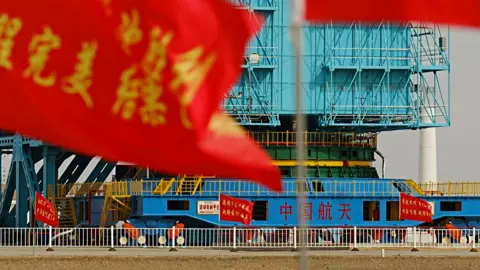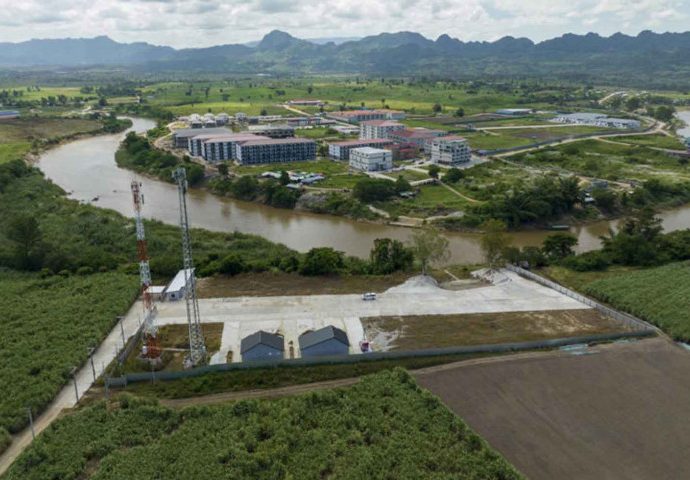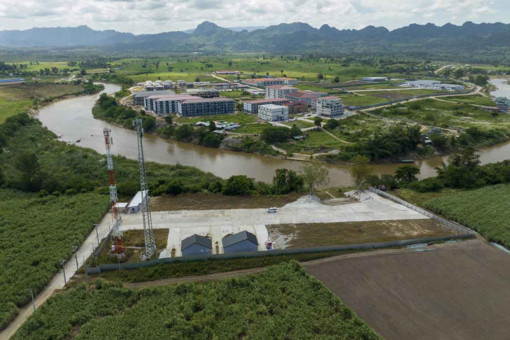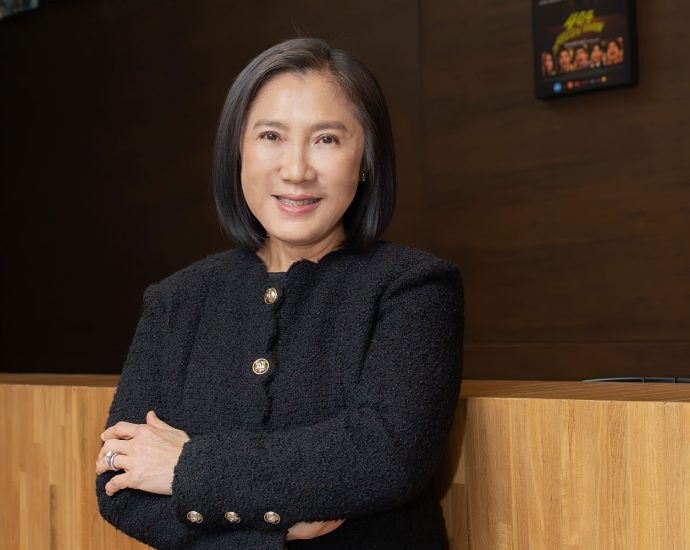China: US high-tech investment ban to hurt global supply chain – Asia Times
The Chinese government expressed diplomatic discontent to the United States after the Biden administration finalized a set of rules to restrict American individuals and companies from investing in China’s three high technology sectors.
The Final Rule, which aims to implement the Executive Order signed by US President Joe Biden in August 2023, will limit US investments in the semiconductor, artificial intelligence and quantum computing sectors in mainland China, Hong Kong and Macau, the Treasury Department said Monday. The rules will take effect on January 2.
US investors will also be required to inform the Treasury about their investments in some less advanced technologies that may lead to the threat to the national security of the US, according to the Treasury Department.
“China expresses strong dissatisfaction and firm opposition to the United States’ announcement of investment restriction rules against China,” Lin Jian, a spokesperson of the Chinese Foreign Ministry, said in a media briefing on Tuesday.
Lin said China has lodged representations with the US and will take all necessary measures to firmly safeguard its legitimate rights and interests.
“It once again shows that American politicians seek their own political interests, undermining normal investment and trade, the free market and economic order. This will harm the global supply chain,” Hong Kong Chief Executive John Lee said Tuesday.
“This harms the interests of others,” he said, as well as those of “the US as a nation, its people and its companies. They will reap what they sow.”
The Hong Kong government on Monday issued a policy statement, which clearly sets out the government’s policy stance and approach to promote the development of AI adoption by the financial services sector.
Prohibited and notifiable transactions
Washington’s Final Rule, officially called “Addressing US Investments in Certain National Security Technologies and Products in Countries of Concern,” specifically directs the Treasury Secretary to issue regulations that prohibit US persons from engaging in certain transactions involving certain technologies and products that pose a particularly acute national security threat to the US.
It prohibits US investment in transactions related to China’s development of:
- electronic design automation software, certain fabrication and advanced packaging tools; the design, fabrication, or packaging of certain advanced integrated circuits; and supercomputers;
- quantum computers and production of critical components, certain quantum sensing platforms, and quantum networking and quantum communication systems;
- any AI system designed to be exclusively used for, or intended to be used for, certain end uses; any AI system that was trained using a specified quantity of computing power, and trained using a specified quantity of computing power using primarily biological sequence data.
If the transactions in the three categories are not covered by the prohibited transaction definition, US investors will be subject to the notification requirement.
”US investments are often more valuable than their capital alone, because they can also include the transfer of intangible benefits,” said the Treasury Department’s Office of Investment Security (OIS).
“Intangible benefits that often accompany US investments and help companies succeed include: enhanced standing and prominence, managerial assistance, access to investment and talent networks, market access, and enhanced access to additional financing.”
The OIS said certain investments by US persons into a country of concern can be exploited to accelerate the development of sensitive technologies or products – including military, intelligence, surveillance, or cyber-enabled capabilities – in ways that negatively impact the national security of the US.
”The US has taken frequent actions to suppress and slow the rapid growth of China’s high technology sectors,” Li Haidong, director of Center for American Studies, China Foreign Affairs University, told the Global Times.
“This deviates from the United States’ basic stance of maintaining stable relations with China, and also deviates from the American public’s hope that political elites will focus their energy on domestic issues, instead of creating external conflicts,” Li said.
His comments came ahead of the US presidential election, which will take place on November 5.
AI computing power
On August 9 last year, President Biden signed an Executive Order to declare a national emergency to address the threat to the US posed by countries of concern that seek to develop and exploit sensitive technologies or products critical for military, intelligence, surveillance or cyber-enabled capabilities.
On June 21 this year, the Treasury Department proposed a set of rules on outbound investment screening. It said it would set the AI computing power thresholds for a prohibited transaction and a notifiable transaction.
The Final Rule now sets the AI computing power’s speed threshold for a prohibited transaction at 1025 floating point operations (FLOPs) for an AI system generally, and at 1024 FLOPS for an AI system using primarily biological sequence data.
It also sets the threshold for a notifiable transaction involving the development of AI systems at 1023 FLOPS. All these thresholds are the lowest in the government’s proposed ranges, meaning that the Final Rule has broad coverage.
Jack Clark, former policy director of OpenAI, writes in his blog that the notifiable threshold general-purpose AI systems is set at 1026 FLOPS in the US and 1025 FLOPS in the European Union.
To illustrate what this means in practice, he said H100 SXM, Nvidia’s latest graphic processing unit, can train AI systems at different speeds but the cost for training at a speed of 1026 is 10 times that for 1025.
He said A100, a slower AI chip, can also run at a speed of 1026 but it would cost even more.
He said the 1025 threshold in the EU will eventually hit more companies than regulators anticipated.
Read: Beijing: new Treasury rules amount to ‘decoupling’
Follow Jeff Pao on X: @jeffpao3
Commentary: MaNaDr Clinic scrutiny is an opportunity for telemedicine to prove itself

Under the upcoming Health Information Bill, it is proposed that both public and private sector patient information including consultation dates, diagnoses and medicines prescribed be automatically entered into the central National Electronic Health Record. With consult data captured centrally for both in-person and telemedicine, much richer analyses can be conducted to compare the different modalities for patient care outcomes.
Finally, there have been calls for an honour-based sick leave system, at least for a specific number of days. In 2022, Health Minister Ong Ye Kung shared his hope that such a model becomes “a more prevalent practice”, noting also that consulting simply for MCs is “not the best use of the doctor’s precious time and resources”.
As we move forward, should doctors continue to be tasked by society to police sick leave on behalf of employers? Or are there changes in workplace culture and attitudes that could be more fruitful?
“Never waste a good crisis” as the saying goes. Singapore has the opportunity to undertake a root and branch review of telemedicine in the context of how it is today and how it should be tomorrow.
Singapore does not have geographic access issues the way that much larger countries with dispersed populations may have, and telemedicine’s use case in expanding access may be more tightly circumscribed. On the other hand, we have reliable, high speed internet access and with advancements in video analytics and artificial intelligence, perhaps coupled with smart phone-enabled diagnostics, telemedicine platforms may soon be able to assess vital signs and conduct even “physical examinations” virtually.
It would be a pity to dismiss or downplay telemedicine now, when we have an opportunity to promote it in settings of greatest value.
Dr Jeremy Lim is a medical doctor and public health specialist. He is author of Myth or Magic – The Singapore Healthcare System. Koh Lin Pin is an incoming medical student at the Yong Loo Lin School of Medicine, National University of Singapore.
IN FOCUS: Can more be done to deal with bullies in Singapore schools?

SINGAPORE: It began with being ostracised, escalated to dropping out of school and came to a head when she was blackmailed into having sex.
The first signs appeared when Leah, who asked to use a pseudonym, was in Secondary 2 and part of a “squad” of about five students in their girls’ school.
But she was the odd one out; unable to relate and feeling excluded from conversations.
At that point, it had been a year since she was formally diagnosed with depression, anxiety and obsessive compulsive disorder or OCD – and made the mistake of confiding this to the group.
They promptly shunned her, spread word of her mental health struggles and shamed her for also harming herself. When confronted, they told her she was “too different” for their liking.
“At that time, it felt really cruel,” said Leah, now 22. “I was upset and I did feel betrayed.”
Pushed to the brink, she decided to drop out and enrol in a private institution to take her O-Levels.
But the girls weren’t done, with one of them threatening to tell Leah’s parents about her mental health issues unless she slept with the girl’s ex-boyfriend.
While perhaps less visible, Leah’s case was no less insidious than a spate of physical and visceral bullying instances that have surfaced in recent weeks.
In September, a video of a Bukit View Secondary School pupil being taunted and kicked to the ground made online rounds, prompting police investigations.
A week later, an online clip of a Qihua Primary School student being assaulted by an older boy led to the arrest of five teenagers.
And earlier in October, a Meridian Secondary School pupil reportedly ruptured her right eardrum after being attacked by schoolmates.
According to the Ministry of Education (MOE) the average number of bullying incidents has remained “steady” in the last five years.
For every 1,000 students, there were an average of two incidents in primary schools and six incidents in secondary schools annually, for any form of bullying and both inside and outside school.
Yet questions have since been raised, including by lawmakers, on whether schools and teachers are sufficiently equipped today to deal with bullying. If the answer is no, is it time then for other authorities such as the courts and the police to play a bigger role? And how do parents fit into the process?
While there may be policies and interventions in schools, bullying these days extends beyond the school to include the virtual environment, chairperson of the Government Parliamentary Committee (GPC) for Education Patrick Tay told CNA.
There are more situations where educators are unable to handle bullying and may even “put themselves at risk to threats and harms”, said Mr Tay, who’s Member of Parliament for Pioneer.
“It is therefore imperative that educators are not just equipped to handle such scenarios, but that law enforcement and other community services agencies beef up their capabilities to work with schools and the community, to combat egregious bullying behaviours and the bullies themselves who may be facing issues beyond the school environment.”
Whether Trump or Harris wins, US must redefine its Asia strategy – Asia Times
This article was orginally published by Pacific Forum. It is republished with permission.
Just days away from what appears to be an extremely close US election, pundits are hastily trying to make sense of both major candidates’ potential foreign policy platforms. In the battle between Vice President Kamala Harris and former President Donald Trump, each has sought to portray the other as somehow weak on China in an effort to out-hawk the opposition.
Trump has called for 60% tariffs on all of Chinese imports, thereby threatening global financial markets that are still reeling from Covid-19 pandemic recovery and struggling to adjust to US-China decoupling in critical technology sectors.
Harris has insisted that her goal as president would be “making sure the United States of America wins the competition for the 21st century.”
To some national security commentators watching from Asia, there is little difference between two candidates. Both, after all, view American power as indispensable and see their country locked in zero-sum competition with China.
That view is at odds with and keeps them and their political parties from coming to terms with two difficult truths, recognition of which is prerequisite to construction of a more successful Asia strategy:
- The United States no longer enjoys unrivaled status as the world’s sole superpower.
- China is not universally viewed with suspicion – let alone hostility – throughout the region.
True, by most objective measures the United States’ position in Asia at the end of 2024 is more secure than it was in 2020.
The Biden administration has secured access to nine bases in the Philippines as part of the Enhanced Defense Cooperation Agreement put on hold under Rodrigo Duterte (2016-2022). In the span of one month in 2023, the administration established a new US-Japan-South Korea trilateral with its two East Asian allies and concluded a double upgrade in the US-Vietnam Comprehensive Strategic Partnership.
The Lowy Institute’s newly released Asia Power Index confirms this positive trendline, finding that the United States remains the most powerful country in Asia, and that while Beijing continues to chip away at Washington’s lead, “China’s power is plateauing” rather than surpassing that of the United States.
Despite those noteworthy accomplishments, however, the longer-term trendline for the United States is concerning.
As Washington continues to project a strategy that implicitly assumes American primacy while it abstains from the evolving regional economic architecture by rejecting free trade deals, the United States is increasingly losing influence in Asia.
Official inattention and inconsistency are largely to blame for the current situation and can be corrected – but time is running out.
While US policymakers frequently make the point that the United States is the largest source of foreign direct investment in Southeast Asia, this is only true if you consider total investment stocks. According to new data from the Lowy Institute, over the last decade China has invested significantly more in the region than has the United States ($218 billion to $158 billion).
Wary of alienating a country that is their biggest trading partner and an inescapable geographic reality, Southeast Asian states are unwilling to join what they perceive as US-led efforts to contain China.
According to a recent survey by the ISEAS-Yusof Ishak Institute, more Southeast Asian states now say that they would choose China over the United States if forced to pick between the two, the first time Beijing has eclipsed Washington as the partner of choice.
Increasingly bellicose anti-China rhetoric in Washington – never more evident than in an election year in which each party seeks to outbid the other as tougher on China – has not been balanced by a positive vision for regional stability that embraces economic statecraft or conventional tools of diplomacy.
Whether Democrat or Republican, the next administration has an opportunity to reframe Washington’s Asia policy in response to regional demand for a more active and balanced US role in the region. The incoming president should consider three guiding principles to get the balance right.
First, Asian states want a more benign and sustainable US presence, one not simply predicated on security partnerships and military bases but capable of delivering much needed public goods such as economic investment and development finance to meet the needs of Asia’s rapidly growing middle classes.
Asia’s middle class is expected to grow to 3.5 billion by 2030, making it the largest in the world. A 2019 report by the Asian Development Bank estimated that the infrastructure needs of developing countries in the Indo-Pacific would amount to $1.7 trillion a year through 2030 when climate change adaptation was factored in.
Yet according to one recent study, official development finance to Southeast Asia in 2022 was at its lowest level since 2015 in real terms.
Secondly, it’s not necessary for the United States to be the single most powerful player for it to make positive contributions to regional order. Washington policymakers are deluding themselves if they are crafting regional strategy from an assumption that the US still enjoys unchallenged primacy in Asia.
Primacy should no longer be the lodestar of US strategy and is an unrealistic goal anyway. A foreign policy based on primacy squanders scarce resources and overstretches policymakers at a time when American voters are most concerned with the economy and healthcare.
Third, smaller states want options. While it has become cliché, the reality is that Asian states do not want to be forced to choose between China and the US. China has been the dominant economic partner for the entire region for some time, and it isn’t going away.
By contrast, the United States is seen as fickle and often a source of instability. In Indonesia and Malaysia, citizens have boycotted American companies such as McDonald’s and Starbucks to express their outrage over US support for Israel’s war in Gaza.
Indonesia and Malaysia are both significant regional partners for Washington and proverbial “swing states,” whose populations frequently put pressure on their political leaders to distance their countries from the United States. Policymakers in Washington therefore need to be more cognizant of how their country is perceived in the region.
In light of these limitations on US power and influence, the next president should recognize the value of America’s alliances and partnerships across the globe, which act as a force multiplier when rowing in the same direction. Washington should continue to empower partners and allies that are willing to play constructive roles in preserving a rules-based (not necessarily liberal) international order.
Ultimately, neither candidate is likely to follow these prescriptions to a tee. Neither party shows any sign of abandoning the current trajectory, which privileges rivalry with China at all costs with a vaguely defined goal of “winning” that competition.
Primacy may be too baked into the cake for any US leader to let go of. In a climate of great power competition globally and political brinkmanship at home, no candidate sees anything short of US dominance as a viable platform.
However, the next American leader may be forced to reconcile with shifting voter preferences. While foreign policy is never a priority issue in any US election, a large percentage of Americans say that it ranks relatively high on their list of concerns: 62% of all voters indicate that foreign policy is very important in determining whom they will vote for (that breaks down to 70% of Trump supporters and 54% of Harris supporters).
Each candidate has sought to be seen as the candidate of change. While the rest of the world is unlikely to view this election that way (both are incumbents to varying degrees), change is precisely what US Asia strategy needs. The election provides a valuable opportunity to reimagine US goals in light of 21st-century global realities.
Hunter Marston (@hmarston4), a PhD candidate at Australian National University, is a Southeast Asia associate with 9DASHLINE and an adjunct research fellow with La Trobe Asia.
China’s youngest-ever astronauts blast off from the Gobi desert

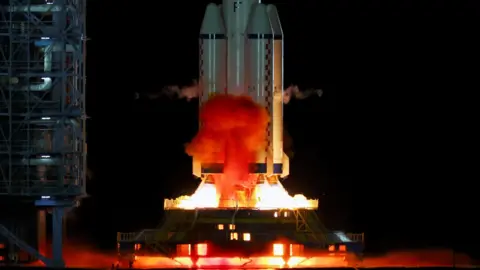 Reuters
ReutersThe ground vibrates beneath us as soon as the countdown ends and the spacecraft takes to the skies. Flames shoot out of the rocket launcher lighting up the Gobi Desert, which is then filled with a deafening roar.
The BBC has been given rare access to Jiuquan Satellite launch centre in Gansu and we are just over a kilometre away from blast-off.
The Shenzhou 19 spacecraft is crewed by three taikonauts – China’s word for astronauts – who are the latest in a series of explorers to head to the country’s homegrown space station, Tiangong, or “Heavenly Palace”.
They will use it as a base for six months to conduct experiments and carry out spacewalks as the country tries to gain experience and intelligence for its eventual mission to put someone from China on the Moon by 2030.
Just two years ago, President Xi Jinping declared that “to explore the vast cosmos, develop the space industry and build China into a space power is our eternal dream”.
But some in Washington see the country’s ambition and fast-paced progress as a real threat.
Earlier this year, Nasa chief Bill Nelson said the US and China were “in effect, in a race” to return to the Moon, where he fears Beijing wants to stake territorial claims.
He told legislators that he believed their civilian space programme was also a military programme.

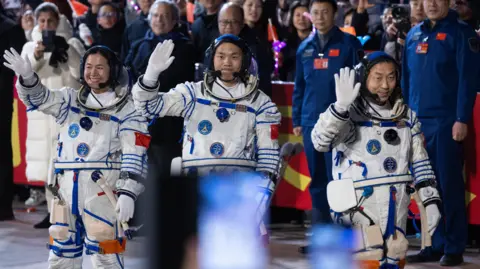 EFE
EFE‘Dreams that spark glory’
However, in Dongfeng Space City, a town built to support the launch site, China’s space programme is celebrated.
Every street light is adorned with the national flag.
Cartoon-like astronaut figurines and sculptures sit in the centre of children’s parks and plastic rockets are a centrepiece on most traffic roundabouts.
A huge poster with Xi Jinping on one side and a photo of the Shenzhou spacecraft on the other greets you as you drive into the main compound.
Hundreds have gathered in the dark after midnight to wave flags and brightly coloured lights as the Taikonauts make their last few steps on Earth before heading to the launch site.
The brass band strikes up Ode to the Motherland as young children, kept up late for the occasion, their cheeks adorned with the Chinese flag, all shout in full song.
This is a moment of national pride.
The pilot of this mission, Cai Xuzhe, is a veteran but he’s travelling with a new generation of Chinese-trained taikonauts born in 1990 – including China’s first female space engineer, Wang Haoze.
“Their youthful energy has made me feel younger and even more confident,” he told the gathered media ahead of take-off.
“Inspired by dreams that spark glory, and by glory that ignites new dreams, we assure the party and the people that we will stay true to our mission, with our hearts and minds fully devoted. We will strive to achieve new accomplishments in China’s crewed space programme.”
Standing to his left, beaming, is Song Lingdong.
He recalls watching one of China’s first space station missions as a 13-year-old with “excitement and awe”. He chose to become a pilot in the hope that this is how he could serve his country.
All three convey their deep sense of national pride, and state media has emphasised that this will be its “youngest crew” to date.
The message is clear: this is a new generation of space travellers and an investment in the country’s future.
China has already selected its next group of astronauts and they will train for potential lunar missions as well as to crew the space station.
“I am determined not to let down the trust placed in me,” says Song. “I will strive to make our country’s name shine once again in space.”

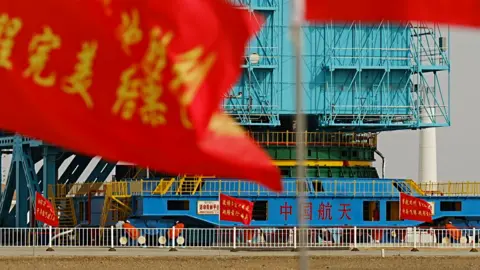 BBC/ Xiqing Wang
BBC/ Xiqing WangChina’s name has been “shining brightly” a lot lately when it comes to headlines about its space programme.
Earlier this year, the country achieved a historic first by retrieving rock and soil samples from the far side of the Moon.
In 2021, China safely landed a spacecraft on Mars and released its Zhurong rover – becoming just the second nation to do so.
China also has a fleet of satellites in space and has plans for many more.
In August it launched the first 18 of what it hopes will eventually be a constellation of 14,000 satellites providing broadband internet coverage from space, which it hopes will one day rival SpaceX’s Starlink.
Elon Musk, Starlink’s chief executive, admitted on his own platform X that China’s space programme is far more advanced than people realise.
But others in the US are voicing even greater concerns, as they fear this technology can be weaponised.
The head of US Space Command, General Stephen Whiting, told a space symposium in April that China and Russia were both investing heavily in space at a “breath-taking speed”.
He claimed that since 2018, China has tripled the amount of intelligence, surveillance and reconnaissance satellites it has in orbit, building a “kill web over the Pacific Ocean to find, fix, track and target United States and allied military capabilities”.
The new space race
China’s space exploration is a “collective mission for humanity”, says Li Yingliang, director of the general technology bureau of China’s Manned Space Agency, dismissing US concerns as “unnecessary”.
“I don’t think this should be called a competition… China has long upheld the notion of peaceful use of space in its manned space programme. In the future, we will further develop international co-operation in various aspects of manned space technology, all based on sharing and collaboration,” he adds.
But the new space race is no longer about getting to the Moon. It’s about who will control its resources.
The Moon contains minerals, including rare earths, metals like iron and titanium – and helium too, which is used in everything from superconductors to medical equipment.
Estimates for the value of all this vary wildly, from billions to quadrillions. So it’s easy to see why some see the Moon as a place to make lots of money. However, it’s also important to note that this would be a very long-term investment – and the tech needed to extract and return these lunar resources is some way off, writes the BBC’s science editor Rebecca Morelle.
Chinese experts at the launch centre were keen to point out the benefits of Beijing’s space station experiments.
“We study bones, muscles, nerve cells, and the effects of microgravity on them. Through this research, we’ve discovered that osteoporosis on Earth is actually similar to bone loss in space. If we can uncover unique patterns in space, we might be able to develop special medications to counteract bone loss and muscle atrophy,” said Zhang Wei, from the Chinese Academy of Sciences.
“Many of these experimental results can be applied on Earth.”

 BBC/ Xiqing Wang
BBC/ Xiqing WangChina is, at times, trying to downplay its advances.
At the launch of a roadmap for its space ambitions, which include building a research station on the Moon, returning samples of Venus’s atmosphere to Earth and launching more than 30 space missions by the middle of this century, Ding Chibiao from the Chinese Academy of Sciences said the country did not have a great number of achievements “compared to developed nations”.
And even here at the launch centre, they admit to “significant challenges” as they try to land a crew on the Moon.
“The technology is complex, there’s a tight schedule, and there are a lot of challenges,” said Lin Xiqiang, spokesperson for the China Manned Space Agency.
“We’ll keep up the spirit of ‘two bombs and one star’. We will maintain our self-confidence and commitment to self-improvement, keep working together and keep pushing forward. We’ll make the Chinese people’s dream of landing on the Moon a reality in the near future.”
That’s perhaps why President Xi appears to be prioritising the country’s space programme even as the economy is in a slow decline.
And even though they are bringing along international press to witness their progress – there are key restrictions.
We have been kept in a hotel three hours from the launch site and transported back and forth by bus, a total journey of 12 hours, rather than leave us on site for a few hours.
A simple trip to a friendly local restaurant was carefully guarded by a line of security personnel.
We also noticed a large sign in town holds a stern warning: “It’s a crime to leak secrets. It’s an honour to keep secrets. You’ll be jailed if you leak secrets. You’ll be happy if you keep secrets. You’ll be shot if you sell secrets.”
China is taking no chances with its new technology, as its rivalry with the United States is no longer just here on Earth.
The world’s two most powerful countries could soon be staking territorial claims well beyond this planet.
Police target 110 victims in Myanmar for rescue

The police’s Anti-Trafficking in Persons Division (ATPD) is stepping up efforts to help rescue about 110 trafficking victims in Myanmar.
Pol Maj Gen Sarut Kwaengsopha, commander of the ATPD, said on Tuesday the division will work with the Foreign Affairs Ministry, the police attache at the Thai embassy in Myanmar and the chairman of the Township Border Committee to find ways to help save them.
The move comes after the Civil Society Network for Victim Assistance in Human Trafficking on Saturday sent open letters urging Prime Minister Paetongtarn Shinawatra, agencies concerned and the embassies of nine countries to take action to help secure the release of 110 victims of trafficking.
Regarding foreigners who are rescued and brought back to Thailand, they will undergo the national referral mechanism process that is designed to identify, protect and assist victims of trafficking, Pol Maj Gen Sarut said.
The network said the victims from nine countries were lured by a Chinese mafia syndicate and forced to work as scammers in Myanmar.
The network sent similar letters to leaders of ethnic armed groups in Myawaddy, in Myanmar’s Karen State, including the Karen Border Guard Force (BGF) and the Democratic Karen Buddhist Army (DKBA).
It said 36 Filipinos and one Moroccan are being held in the BGF-controlled area, while 73 people from various countries are in DKBA-controlled territory.
It said a transnational syndicate led by Chinese nationals used social media to offer high-paying jobs in Thailand.
The victims were forced to illegally cross the border into Myanmar through Tak’s Mae Sot district.
“Given Thailand’s recent election to the United Nations Human Rights Council for 2025-2027, this is a critical moment for the nation to actively support humanitarian rescue operations,” the network said.
ATPD targets 110 victims in Myanmar for rescue

The police’s Anti-Trafficking in Persons Division (ATPD) is stepping up efforts to help rescue about 110 trafficking victims in Myanmar.
Pol Maj Gen Sarut Kwaengsopha, commander of the ATPD, said on Tuesday the division will work with the Foreign Affairs Ministry, the police attache at the Thai embassy in Myanmar and the chairman of the Township Border Committee to find ways to help save them.
The move comes after the Civil Society Network for Victim Assistance in Human Trafficking on Saturday sent open letters urging Prime Minister Paetongtarn Shinawatra, agencies concerned and the embassies of nine countries to take action to help secure the release of 110 victims of trafficking.
Regarding foreigners who are rescued and brought back to Thailand, they will undergo the national referral mechanism process that is designed to identify, protect and assist victims of trafficking, Pol Maj Gen Sarut said.
The network said the victims from nine countries were lured by a Chinese mafia syndicate and forced to work as scammers in Myanmar.
The network sent similar letters to leaders of ethnic armed groups in Myawaddy, in Myanmar’s Karen State, including the Karen Border Guard Force (BGF) and the Democratic Karen Buddhist Army (DKBA).
It said 36 Filipinos and one Moroccan are being held in the BGF-controlled area, while 73 people from various countries are in DKBA-controlled territory.
It said a transnational syndicate led by Chinese nationals used social media to offer high-paying jobs in Thailand.
The victims were forced to illegally cross the border into Myanmar through Tak’s Mae Sot district.
“Given Thailand’s recent election to the United Nations Human Rights Council for 2025-2027, this is a critical moment for the nation to actively support humanitarian rescue operations,” the network said.
PM vows no delays in iCon case

Prime Minister Paetongtarn Shinawatra reassured the public that the case concerning The iCon Group will proceed without delay now it has been transferred to the Department of Special Investigation (DSI).
Concerns have surfaced regarding the possibility of delays and the early release of suspects, but Ms Paetongtarn said the DSI and the Royal Thai Police (RTP) are in continuous collaboration.
She noted that the police have already provided all the necessary information about the case to the DSI, making delays unlikely.
When asked if she could buoy the public’s confidence in the case proceeding at full speed, the prime minister simply replied, “Yes. Yes.”
The Consumer Protection Police Division (CPPD) reportedly handed over more than 92,000 pages of related documentation to the DSI on Monday to determine if the case meets the criteria for a special investigation.
The DSI accepted the case on Tuesday and is now coordinating with the Office of the Attorney General to have financial and tax experts support the investigation, especially to analyse complex financial trials and tax records.
Regarding the transfer of the case to the DSI, Central Investigation Bureau (CIB) deputy commissioner Pol Maj Gen Suwat Saengnum said the move was in line with the Emergency Decree on Borrowings Which Are Regarded as Public Cheating and Fraud BE 2527 (1984).
He said police have amassed considerable evidence indicating widespread investor losses, fitting the legal definition of a special case due to the high number of victims (over 8,000) and damages exceeding 100 million baht.
Attorney Withoon Keng-ngarn, who represents 11 of the 18 suspects (referred to as “bosses” of The iCon Group), including its CEO Warathaphon “Boss Paul” Waratyaworrakul, said bail requests for 15 will be considered next week, but bail for the other three has not yet been arranged.
He said The iCon Group operated under legitimate business practices and was not a Ponzi scheme, saying it functioned as a legitimate indirect-selling network with clear data about its operations. The CIB has flagged it as a potential Ponzi scheme.
Silver screen success
Over the past three years, Thailand’s film industry has gained momentum following the pandemic restrictions. People are spending more time outside and returning to cinemas.

Jina Osothsilp, Chief Executive Officer of GDH 559 Co, Ltd.
This year, the Thai blockbuster family drama Lahn Mah left millions of filmgoers across Southeast Asia in tears.
Known in English as How to Make Millions Before Grandma Dies, it was selected as Thailand’s entry at the 97th Academy Awards.
Since it premiered six months ago, the movie has raked in almost 2 billion baht worldwide.
It was the highest-grossing Thai film of 2024, with 184 million baht in combined receipts in Bangkok and Chiang Mai alone as of early October.
The National Federation of Thai Film Associations has selected it to represent Thailand as its submission for the best international feature film category at the 97th Academy Awards.
Not only is the selection the latest achievement for the blockbuster, but it also represents the culmination of the work of GDH studio head Jina Osothsilp and her team, powered by the backing of its studio.
Ms Jina, chief executive of GDH 559, whose name stands for gross domestic happiness, said GDH has been pushing Thai films to screens abroad since its inception in 2016, especially in Southeast Asian countries such as Singapore and Malaysia as well as other Asian markets such Taiwan, Hong Kong and South Korea, to great acclaim.
The films shown abroad were mostly horrors and thrillers, genres seen as having universal appeal.
But the company has recently been trying to push out comedies and local thrillers such as How to Make Millions Before Grandma Dies, a film which explores concepts such as filial piety and patriarchy through a story about love and relationships across different generations in a family, as another step to raising the popularity of Thai films.
“Our company was founded on the principle of producing quality films that meet international standards, elevating the Thai film industry for future generations,” said the GDH executive. She reminisced about her early days at an advertising company, where she and her team pushed creative boundaries to deliver impactful commercials.
These principles remain unchanged at GDH, where the team strives to think outside the box, creating entertaining films that balance commerce and art.
“The company does not solely target mass-market films for guaranteed box office success; we also embrace diverse ideas,” said Ms Jina.
Moreover, films do not have a perfect formula to guarantee success; thus, the team must be scrupulous regarding every detail and meticulous about every production step. Everyone from scriptwriters, lighting crew and camera operators to actors, producers and directors must work together in unison, she added.
“When the film is released, regardless of the audience feedback, we believe we’ve given it all,” Ms Jina said.
“If audiences are inspired by the film’s message and apply it to their lives, which change themselves, those around them and society in a positive and meaningful way, that is the true success of filmmaking,” she added.
Ms Jina has always believed that behind every success is a great team, whether it’s the talented actors or the skilled crew members behind the scenes.
“Everyone is part of an amazing team, and we believe that the success of this film will encourage filmmakers to create fresh, new content, elevating the standards of the film industry,” she said.
“We feel that family films about love and gratitude are truly universal. Initially, there was some concern that a movie like this might not make a lot of money. But we wanted to create a good film, and we believe that good films should enlighten the audience. When we, as a board, read the script, we all admired it and believed it was an excellent script. We felt that if we didn’t make this movie, we’d regret it deeply,” Ms Jina said.
“A tearjerker might not guarantee success at the box office, but we believed in the quality of the script and the team’s passion to make it happen,” she added.
Such instincts proved right and the movie received positive feedback and an overwhelmingly warm welcome from audiences across the country and abroad. On the promotional tour in Vietnam, many young people left the cinema in tears and ran up to hug Grandma Taew, the 78-year-old actress who played the film’s titular matriarch, remarking how the movie reminded them of their grandma and thanking the company for making a great film.
She said the company has been passing on opportunities for new directors who have experience in making TV series and commercials to join the team under the supervision of the producers, bringing diverse ideas to the screen.
In August, the company released the romantic drama The Paradise of Thorns, the first feature film directed by Naruebet Kuno, known for the famous TV series I Told Sunset About You in 2022.
The film tells the story of Thongkam and Sek, a gay couple who own a home and durian orchard in Mae Hong Son.
Sek dies unexpectedly, and the property is inherited by Sek’s mother, leaving Thongkam without legal rights to their shared property.
The fight for his rights is a reflection of the challenges faced by same-sex couples in Thai society. The film has been selected for screening at the 49th Toronto International Film Festival.
Ms Jina said the success of Bad Genius (2017) in China offers solid proof that Thai filmmakers are capable of generating excitement in the international market.
Jina Osothsilp
Chief Executive Officer of GDH 559 Co, Ltd.
To challenge China, the next US president should fix trade – Asia Times
This article was originally published by Pacific Forum. It is republished with permission.
In the September presidential debate, former President Donald Trump and current Vice President Kamala Harris had sharply contrasting views on issues ranging from energy to immigration to policy toward China and the Middle East.
Yet, both agreed that tariffs were useful for US foreign policy.
The debate started with tariffs, and the two candidates went back and forth on the likelihood that the new tariffs would cause inflation. By the end of the debate they returned to their discussion on tariffs, where they disagreed on the sectors where they thought tariffs should be imposed and on which countries should be targeted – but agreed that tariffs are useful.
Regardless of the detrimental consequence of tariffs, including inflation, the candidates emphasized the need to impose them to protect critical sectors and spur domestic manufacturing.
The debate clearly demonstrated the arrival of a new era in the United States, one in which the two parties are recalibrating the balance between national security and economics.
Biden’s trade war and Trump’s
The United States has a growing list of grievances about Beijing’s mercantilist practices. These include
- widespread market-access restrictions, from equity caps on investment to regulatory harassment;
- pervasive subsidies directed at national champions that tilt the competitive playing field against foreign firms in China and in third markets; and
- widespread forced technology transfer and intellectual property theft.
To protect domestic industries vital to national security and incentivize China to change its practices, both the Trump and Biden administrations have imposed tariffs on Chinese products.
In March 2018 President Trump announced the administration would impose a 25% tariff on imported steel and a 10% tariff on imported aluminum. Following the announcement, the Trump administration imposed several rounds of tariffs on steel, aluminum, washing machines, solar panels as well as goods specifically from China, impacting more than $380 billion worth of trade at the time of implementation and amounting to a tax increase of nearly $80 billion.
President Biden said in a 2019 speech: “President Trump may think he’s being tough on China, but all he has delivered is more pain for American farmers, manufacturers, and consumers.”
Yet, the Biden administration has largely upheld existing tariffs, with some exceptions. These include suspending certain tariffs on European Union imports, replacing tariffs with tariff-rate quotas (TRQs) on steel and aluminum from the EU and UK, as well as steel from Japan, and allowing tariffs on washing machines to expire after a two-year extension.
In May 2024, the Biden administration announced additional tariffs on $18 billion of Chinese goods, resulting in a tax increase of $3.6 billion.

President Biden’s trade policy differs from the former president’s in that he seeks to increase production and jobs in a select group of emerging high-tech industries. Additionally, he has tightened trade restrictions with China under the “Small Yard, High Fence” approach, limiting the sale of American technology to Beijing while directing federal subsidies to US manufacturers competing with Chinese manufacturers. Another key difference in President Biden’s trade policy is that his strategy relies on bringing international allies together to counter China through a mix of domestic incentives and potentially coordinated tariffs on Chinese goods.
Weighing Washington’s tariffs on Beijing
Among the reasons countries impose tariffs are:
- to protect domestic industries vital to national security,
- to incentivize foreign countries to change their practices, and
- to raise revenue.
The Trump and Biden administrations both stated they imposed tariffs for the first two reasons.
The Trump administration argued that tariffs were “imposed to encourage China to change its unfair practices” as they “threaten United States companies, workers, and farmers.”
Similarly, after the Biden administration announced tariff hikes on May 14, the White House announced tariff increases were designed “to protect American workers and American companies from China’s unfair trade practices,” including forced technology transfers and theft of intellectual property. The administration also pointed out China’s “growing overcapacity and export surges that threaten to significantly harm American workers, businesses, and communities.”
The biggest problem with the latest round of tariffs imposed in May is that it cannot resolve the problems the Biden administration sought to tackle. Rather than focusing on changing China’s forced technology transfers and protecting intellectual property rights, the tariff increases were more about boosting US industries.
Furthermore, doubts persist about whether tariffs truly benefit the US economy. By raising the cost of parts and materials, tariffs increase consumer prices, and reduce private sector output. This will eventually reduce the return to labor and capital, incentivizing Americans to work less and invest less.
There are numerous studies claiming the negative economic consequences of tariff policy. In August 2019, the Congressional Budget Office (CBO) estimated that the negative GDP effects of recent tariff increases had outweighed the positive ones and were decreasing real output by 0.3%. Meanwhile, the Tax Foundation estimated in July 2023 that the long-run effects would bring GDP down by 0.2% and total employment down by 142,000 jobs.
Another issue with the extended tariff policy is that China has evaded its impact. The US-China trade war and rising risks of investing in China prompted global companies to adopt a “China Plus One” strategy, diversifying production into ASEAN countries. These nations became attractive alternatives to replace China for their relatively young populations, free trade agreements with key players, and prime geographical locations.
However, it wasn’t just American firms relocating to Southeast AsiaChinese manufacturers also shifted operations there. Currently, Chinese firms attempt to bypass tariffs by selling components to manufacturers in ASEAN, where the final goods will not be regulated by the US. In the electric vehicle industry, Chinese companies are rapidly expanding into Southeast Asia, making it difficult to regulate them under current trade policies.
Harming allies
Successive administrations have pursued protectionism, from Trump’s steel and aluminum tariffs to Biden’s Inflation Reduction Act subsidies. Unfortunately, these protectionist policies are also hurting friendly countries. The steel and aluminum tariffs also affect the European Union and Japan, while the subsidies from the Inflation Reduction Act have created challenges for US allies trying to conduct business in the US.
In response, countries like Japan, the EU, Canada, Australia, and others have adopted their own domestic subsidies.
Getting trade policy right
If the new administration aims to achieve the stated goal of changing China’s unfair trading practices, the new president should consider reviewing its trade-distorting policies and reigniting a policy of market-driven economic integration with its allies.
To regulate China’s non-market, export-driven model of growth, the administration should work through international organizations and institutions, just as it did during the recent G7 meeting in Italy. Through channels such as the G7, the WTO and the OECD, the US could build an international coalition demanding that Beijing change direction. If those efforts should prove ineffective, the administration could authorize collective action to rein in China’s exports while simultaneously revitalizing the market economy.
Su Hyun Lee ([email protected]) is a researcher focusing on US-China relations and economic security at the Korea National Diplomatic Academy. Previously, she was a 2021-22 resident Korea Foundation fellow at the Pacific Forum.





